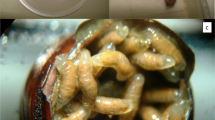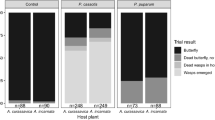Summary
Life stages of the primitive Australian ithomiine butterflyTellervo zoilus and its larval hostplant, the apocynaceous vineParsonsia straminea, were quantitatively assayed for pyrrolizidine alkaloids (PAs). PAs were found in all stages, mainly as N-oxides, being most concentrated in larvae and freshly-emerged adults. Although adults feed at various confirmed PA sources this probably does not compensate for losses, as wild-caught adults had considerably lower concentrations of PAs. The main alkaloid present in both freshly-emerged adults and in leaves of the host-plant was lycopsamine (1b), stored by butterflies in the N-oxide form. Its presence in higher proportion, in relation to intermedine (1a), in larvae, pupae and adults ofTellervo in relation to the host-plants suggests the inversion of intermedine to lycopsamine by the insects. No 14-member ring macrocyclic PAs were detected in either food-plant or butterflies. Several other PAs were found in wild-caught adults reflecting visits to other PA sources. PAs were also found in high concentrations in freshly-emerged individuals of the danaineEuploea core bred onParsonsia straminea. Wild-caughtDanaus affinis had high PA levels acquired from adult feeding. Freshly emergedEuploea raised onIschnocarpus frutescens andDanaus raised onIschnostemma carnosum (both PA-free) were preyed on by the orb weaving spiderNephila maculata, and showed no PAs. In all cases where PAs were present, most butterflies were liberated, usually cut out of the web unharmed, byNephila. The spider's response was not closely linked to PA concentration, however, and may also depend on hunger levels and previous experience with PA-containing butterflies. All control and other non-PA containing butterflies were consumed although rejection of some body parts of freshly-emergedDanaus affinis suggests that compounds other than PAs may be involved.
Similar content being viewed by others
References
Abe F, Yamauchi T (1987) Parsonine, a pyrrolizidine alkaloid fromParsonsia laevigata. Chem Pharm Bull 35:4661–4663
Abe F, Nagao T, Okabe H, Yamauchi T, Nobuhiro M, Ueda I (1990) Parsonsianine, a macrocyclic pyrrolizidine alkaloid from the leaves ofParsonsia laevigata (Studies onParsonsia. III) Chem Pharm Bull 38:2127–2129
Abe F, Yamauchi T, Yaga S, Minato K (1991a) Pyrrolizidine alkaloids fromParsonsia laevigata in Okinawa Island (Studies onParsonsia. V). Chem Pharm Bull 139:1576–1577
Abe F, Tsuneatsu N, Okabe H, Yamauchi T (1991b) Macrocyclic pyrrolizidine alkaloids fromParsonsia laevigata. Phytochemistry 30:1737–1739
Ackery PR (1987) The danaid genusTellervo (Lepidoptera, Nymphalidae) — a cladistic approach. Zool J Linn Soc 89: 203–274
Ackery PR, Vane-Wright RI (1984) Milkweed Butterflies: Their Cladistics and Biology. GB-London: British Museum (Natural History)
Bingley JB (1968) Solvent and temperature effects in the determination of pyrrolizidine alkaloids with 4-dimethylaminobenzaldehyde. Anal Chem 40:1166–1167
Boppré M (1990) Lepidoptera and pyrrolizidine alkaloids. Exemplification of complexity in chemical ecology. J Chem Ecol 16: 165–185
Brown Jr KS (1984) Adult-obtained pyrrolizidine alkaloids defend ithomiine butterflies against a spider predator. Nature 307:707–709
Brown Jr KS (1985) Chemical ecology of dehydropyrrolizidine alkaloids in adult Ithomiinae (Lepidoptera: Nymphalidae). Rev Bras Biol 44:435–460
Brown Jr KS (1987) Chemistry at the Solanaceae/Ithomiinae interface. Ann Missouri Bot Gard 74:359–397
Common IFB, Waterhouse DF (1981) Butterflies of Australia. Sydney: Angus & Robertson
Culvenor CCJ (1978) Pyrrolizidine alkaloids-occurrence and systematic importance in angiosperms. Bot Notiser 131:473–486
Drummond BA, Brown Jr KS (1987) Ithomiinae (Lepidoptera: Nymphalidae): summary of known larval foodplants. Ann Missouri Bot Gard 74:341–358
Edgar JA (1982) Pyrrolizidine alkaloids sequestered by Solomon Island Danainae butterflies. The feeding preferences of the Danainae and Ithomiinae. J Zool (Lond) 196:385–399
Edgar JA, Eggers NJ, Jones AJ, Russel GB (1980) Unusual macrocyclic pyrrolizidine alkaloids fromParsonsia heterophylla A. Cunn andParsonsia spiralis Wall. (Apocynaceae). Tetrahedron Lett 21:2657–2660
Eisner T (1982) For love of nature: exploration and discovery at biological field stations. BioScience 32:321–326
Ehrlich PR (1958) The comparative morphology, phylogeny and higher classification of the butterflies (Lepidoptera: Papilionoidea). Kansas Univ Sci Bull 39:305–370
Hartmann T, Witte L (1995) Chemistry, biology and chemoecology of the pyrrolizidine alkaloids. Pp 155–233in Pelletier (ed.) Alkaloids: Chemical and Biological Perspectives. Vol. 9. GB-Oxford: Pergamon Press
Masters AR (1990) Pyrrolizidine alkaloids in artificial nectar protect adult ithomiine butterflies from a spider predator. Biotropica 22:298–304
Mattocks AR (1967) Spectrophotometric determination of unsaturated pyrrolizidine alkaloids. Anal Chem 39:443–447
Mattocks AR (1968) Spectrophotometric determination of pyrrolizidine alkaloids — some improvements. Anal Chem 40:1749–1750
Mattocks AR (1986) Chemistry and Toxicology of Pyrrolizidine Alkaloids. Academic Press
Nishida R, Kim C, Fukami H, Irie R (1991) Ideamine N-oxides: pyrrolizidine alkaloids sequestered by the danaine butterfly,Idea leuconoe. Agric Biol Chem 55:1787–1792
Orr AG, Ackery PR (1987) Further notes on the biology ofTellervo zoilus (Fabricius). Zool J Linn Soc 89:272–274
Rizk AFM (1991) The pyrrolizidine alkaloids: plant sources and properties. Pp 1–90in Rizk AFM (ed.) Naturally occurring pyrrolizidine alkaloids. Florida: CRC Press
Robinson MH, Robinson B (1973) Ecology and behavior of the giant wood spiderNephila maculata (Fabricius). Smithsonian Contributions to Zoology 149:1–76 (Washington, DC: Smithsonian Institution Press)
Trigo JR, Brown Jr KS (1990) Variation of pyrrolizidine alkaloids in Ithomiinae: a comparative study between species feeding on Apocynaceae and Solanaceae. Chemoecology 1:22–29
Trigo JR, Witte L, Brown Jr KS, Hartmann T, Barata LES (1993) Pyrrolizidine alkaloids in the arctiid mothHyalurga syma. J Chem Ecol 19:669–679
Trigo JR, Barata LES, Brown Jr KS (1994) Stereochemical inversion of pyrrolizidine alkaloids byMechanitis polymnia (Lepidoptera: Nymphalidae: Ithomiinae): specificity and evolutionary significance. J Chem Ecol 20:2883–2899
Trigo JR, Brown Jr KS, Witte L, Hartmann T, Ernst L, Barata LES (1996a) Pyrrolizidine alkaloids in some Apocynaceae and Solanaceae feeding Ithomiinae (Lepidoptera: Nymphalidae). Biol J Linn Soc 58:99–123
Trigo JR, Brown Jr KS, Henriques SA, Barata LES (1996b) Qualitative patterns of pyrrolizidine alkaloids in Ithomiinae butterflies. Biochem Syst Ecol 24:in press.
van den Dool H, Kratz PD (1963) A generalization of the retention index system including linear temperature programmed gasliquid partition chromatography. J Chromatogr 11:463–471
Vasconcellos-Neto J, Lewinsohn TM (1984) Discrimination and release of unpalatable butterflies byNephila clavipes, a neotropical orb-weaving spider. Ecol Entomol 9:337–344
Wiedenfeld H, Röder H (1991) Pyrrolizidine alkaloids fromAgeratum conyzoides. Planta Med 57:578–579
Witte L, Rubiolo P, Bicchi C, Hartmann T (1993) Comparative analysis of pyrrolizidine alkaloids from natural sources by gas chromatography-mass spectrometry. Phytochemistry 32:187–196
Author information
Authors and Affiliations
Rights and permissions
About this article
Cite this article
Orr, A.G., Trigo, J.R., Witte, L. et al. Sequestration of pyrrolizidine alkaloids by larvae ofTellervo zoilus (Lepidoptera: Ithomiinae) and their role in the chemical protection of adults against the spiderNephila maculata (Araneidae). Chemoecology 7, 68–73 (1996). https://doi.org/10.1007/BF01239483
Issue Date:
DOI: https://doi.org/10.1007/BF01239483




